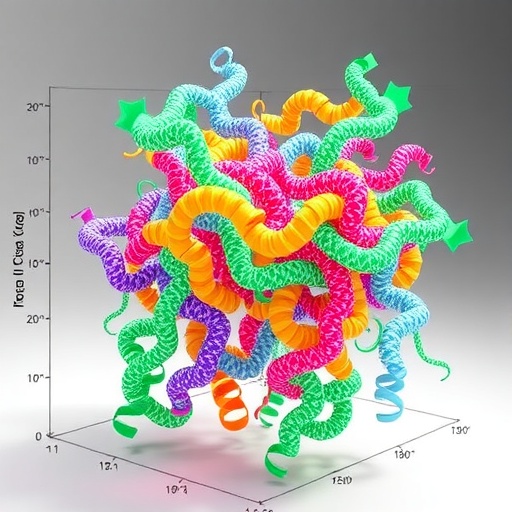In an era where the rapid identification and functional understanding of proteins underpin advancements across biotechnology, medicine, and synthetic biology, a breakthrough has emerged from the intersection of experimental biology and machine learning. A team of researchers has developed an unprecedented resource and computational tool to tackle one of molecular biology’s longstanding challenges: accurately characterizing the catalytic properties and specificity of cytidine deaminases (CDs) on a massive scale. This innovative approach, detailed in the latest issue of Cell Research, centers around AlphaCD, a machine learning-driven model trained on the most comprehensive experimental dataset of CDs to date, boasting the capability to classify and predict enzyme function for over 21,000 protein variants with remarkable precision.
Cytidine deaminases are a diverse family of enzymes playing critical roles in diverse biological processes including RNA editing, immune defense, and genome modification. Their quintessential functionality revolves around catalyzing the conversion of cytidine to uridine in nucleic acids, a biochemical reaction central to processes such as antibody diversification and antiviral responses. Despite their importance, the accurate functional annotation of CDs in vast sequence databases remains elusive owing to wide sequence variability, vague mechanistic understanding, and limited experimental verification. The challenge intensifies when off-target effects—undesired modifications beyond the intended site—complicate therapeutic and biotechnological applications, particularly in the emerging domain of genome editing.
Addressing this gap, researchers embarked on an ambitious experimental campaign to characterize the functional landscape of 1,100 APOBEC-like cytidine deaminases, a predominant subfamily within CDs, by constructing fusion proteins with the well-characterized Cas9 nickase (nCas9) domain and assaying them in human HEK293T cells. This fusion approach leverages nCas9’s DNA-targeting specificity to anchor the deaminase variants at predefined genomic loci, facilitating systematic measurements of key enzymatic parameters: catalytic efficiency, target site window—that is, the nucleotide reach of enzymatic activity—motif preference denoting sequence specificity, and the extent of off-target deamination. The scale of this dataset surpasses previous efforts by an order of magnitude, producing a rich trove of functional annotations that serve as a gold standard for computational modeling.
.adsslot_vAKyjSckie{ width:728px !important; height:90px !important; }
@media (max-width:1199px) { .adsslot_vAKyjSckie{ width:468px !important; height:60px !important; } }
@media (max-width:767px) { .adsslot_vAKyjSckie{ width:320px !important; height:50px !important; } }
ADVERTISEMENT
Building upon this unparalleled dataset, the team integrated multiple layers of protein information—ranging from primary amino acid sequences to three-dimensional structural features and other physicochemical parameters—to train a sophisticated machine learning architecture, AlphaCD. This model not only deciphers the complex relationships underlying enzyme activity and specificity but also achieves high predictive accuracies, with performance metrics reaching 0.92 for catalytic efficiency and 0.84 for off-target activity assessments. Furthermore, AlphaCD adeptly estimates subtler features such as the effective target window (0.73) and intrinsic catalytic motif preferences (0.78), revealing intrinsic enzymatic behaviors critical for both understanding and engineering CDs.
The true power of AlphaCD became evident when the researchers unleashed it upon the vast UniProt protein sequence repository, deploying it to predict functional parameters for a staggering 21,335 cytidine deaminases. This expansion from a thousand experimentally characterized enzymes to predictions for tens of thousands illustrates the transformative potential of coupling big experimental data with machine learning to fill knowledge voids in protein databases. Importantly, the team validated AlphaCD’s predictive credibility through a focused subsampling of 28 CDs, carefully selected to challenge the model’s generalizability. The model’s consistent prediction of catalytic features with accuracies surpassing 0.73 on all evaluated metrics underscored its robustness and reliability.
Beyond prediction, the study illuminated a clear pathway toward functional optimization. In a compelling demonstration of AlphaCD’s utility in protein engineering, alanine scanning mutagenesis was applied to a specific cytidine deaminase variant identified through the model as having high catalytic potential but undesirable off-target activity. By systematically mutating individual amino acids to alanine and assessing the impact, researchers pinpointed modifications that substantially reduced off-target effects while preserving or enhancing catalytic performance. This rational engineering culminated in a cytosine base editor variant exhibiting unprecedented fidelity and efficiency—traits invaluable for precise genome editing applications where minimizing collateral mutations is paramount.
The coupling of high-throughput experimental assays with AI-driven predictions marks a significant evolution in protein science. Historically, experimental characterization of enzyme function has been laborious, costly, and modest in scale, often leaving large sequence families underexplored or misannotated. AlphaCD’s emergence signals a paradigm shift: large-scale, data-rich characterization tamed and extended by machine intelligence, enabling rapid screening, functional annotation, and fine-tuning of proteins across sequence space previously inaccessible. Such advances empower both fundamental biological investigations and translational endeavors, facilitating the discovery of naturally occurring or engineered enzymes with bespoke functionalities.
Another remarkable aspect of this research lies in its integration of structural insights. Many machine learning models rely heavily on sequence information alone, which limits their sensitivity to dynamic, three-dimensional features critical for catalytic activity and substrate recognition. AlphaCD incorporates experimentally-determined and computationally-predicted protein structural features as integral inputs, enhancing its capability to discern subtle conformational determinants that govern enzymatic specificity. This fusion of structural biology and computational learning yields a nuanced functional map of CDs, sharpening predictions that sequence-based models alone might miss.
The implications for therapeutic genome editing are particularly profound. Cytidine deaminase-based base editors have emerged as promising tools for precise single-nucleotide modifications without inducing double-strand breaks. However, off-target edits remain a significant hurdle to clinical deployment, carrying risks of unintended mutations that can lead to genotoxicity or tumorigenesis. By enabling systematic characterization and in silico redesign to optimize specificity and efficiency simultaneously, AlphaCD presents an invaluable framework for accelerating the development of next-generation gene editing reagents that meet stringent safety standards.
Looking forward, the methodology heralded by this study is poised to extend beyond the cytidine deaminase family. The conceptual blueprint—massive experimental data acquisition paired with machine learning-enabled extrapolation and optimization—can be adapted to other enzyme classes and protein families facing similar annotation and engineering challenges. As more large-scale datasets become available, this synergistic approach could democratize high-resolution functional annotation, replacing labor-intensive trial-and-error with data-driven precision design.
The authors also underscore the accessibility and scalability of their platform. By harnessing widely available human cell lines for functional assays and open-access protein databases for sequence information, the research setup avoids reliance on niche or organism-specific systems, increasing the approach’s applicability across laboratories. Moreover, AlphaCD’s scalable computational framework suggests that future iterations could incorporate even more diverse datasets, such as post-translational modification impacts or interaction networks, elevating predictive power further.
Importantly, the research team demonstrates that machine learning models trained on rich experimental datasets can not only predict but also guide rational protein engineering, effectively closing the loop between data-driven hypothesis generation and empirical validation. This aligns with broader trends in synthetic biology and protein design, where iterative cycles of computational prediction and bench testing accelerate innovation and reduce resource expenditure.
At its core, this study reveals how marrying expansive experimental validation with state-of-the-art artificial intelligence reshapes our capacity to understand and harness biological complexity. AlphaCD’s remarkable accuracy across multiple functional dimensions validates the power of such integrative strategies to unravel multifaceted enzymatic profiles hidden within massive sequence landscapes. Ultimately, this paves the way for a future of precision protein engineering, where tailored biomolecules can be designed computationally and realized experimentally with unprecedented speed and fidelity.
In summary, AlphaCD represents a milestone in protein science, delineating a path toward exhaustive functional characterization complemented by actionable predictions for enzyme optimization. Its deployment on tens of thousands of cytidine deaminases reveals an extensive, nuanced functional map previously inaccessible, empowering targeted engineering efforts. As the demand for reliable, high-throughput functional annotation grows, especially with the ever-expanding flood of sequence data, models like AlphaCD will become indispensable in translating raw sequences into biological insight and innovative applications. This groundbreaking fusion of experimental rigor and artificial intelligence not only enriches enzymology but also reshapes the future landscape of protein biotechnology.
Subject of Research: Cytidine deaminases, protein functional characterization, machine learning applications in enzymology.
Article Title: AlphaCD: a machine learning model capable of highly accurate characterization for 21,335 cytidine deaminases.
Article References:
Xu, K., Hua, G., Wu, M. et al. AlphaCD: a machine learning model capable of highly accurate characterization for 21,335 cytidine deaminases. Cell Res (2025). https://doi.org/10.1038/s41422-025-01164-x
Image Credits: AI Generated
Tags: AlphaCD machine learning modelcatalytic properties of proteinscytidine deaminases characterizationenzyme specificity predictionexperimental biology advancementsfunctional annotation of enzymesgenome modification techniquesimmune defense proteinslarge-scale protein analysismachine learning in biotechnologyRNA editing enzymessynthetic biology innovations





